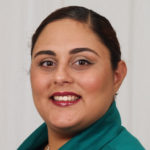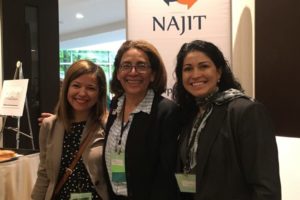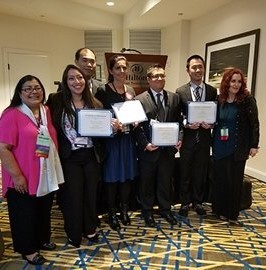Congratulations to everyone on another successful conference! Unfortunately, I was not able to attend, but Rosemary Dann has nothing but great things to say about the conference. It goes without mentioning that a well-run conference is the product of a lot of hard work behind the scenes. It truly is a labor of love, so make sure you thank the organizers and share your feedback when you get a chance.

Proteus
Issue: 2017 Summer Volume XXX Issue No 1Table of Contents
Editor's Corner
Letter from the Editor
Also, summer is here! Time to hang out at the beach (for those of us on the coast, at least), send the kids off to summer camp, and perhaps submit an article to Proteus? We have a new website, a dedicated team of editors, so all that is missing is…your submission. Please consider drafting an article and sending it to us, as this would be an excellent way to keep abreast from afar until our conference in San Francisco next year.
As always, enjoy summer, and stay tuned…
Kind regards,
Dan DeCoursey, Proteus Editor-in-Chief
Meet the Editors

Arianna M. Aguilar has a degree in communications and has been interpreting and translating since 1999. She has been a certified court interpreter in North Carolina since 2005, and master certified Spanish-language court interpreter since 2013. She is president of Latino Outreach Consulting of NC, Inc., a translation and consulting agency, and is a published author. She has given presentations on a range of topics at both NAJIT and American Translators Association (ATA) conferences.

Rosemary Dann currently lives in Phoenix, AZ. (Yes, but it’s a DRY heat.) She holds a B.A. and M.A. in Spanish language and literature, as well as a J.D. degree. She is also a Massachusetts state-certified Spanish-language court interpreter. She has worked as a high school and college instructor, held various law jobs including law clerk to two judges, a public defender, and a private practitioner, and has free-lanced as a judiciary interpreter in Massachusetts, New Hampshire and Florida. She joined NAJIT after attending “The Institute” in 1999 (thank you, Cristina Helmerichs!) and has since served on numerous NAJIT committees and on the Board of Directors for six years, two as chair. She took over the position of editor-in-chief of Proteus upon Nancy Festinger’s retirement from that post, and now turns over the reins to the very capable Athena Matilsky. She is staying on staff as the unofficial “advisor-in-chief”, as she has returned to college as a theater major in performing arts. Her bucket list includes visiting Machu Picchu, seeing her son married, and appearing in a national TV commercial.

Dan DeCoursey is a state and federally certified court interpreter in San Diego, as well as an ATA-certified Spanish>English translator. After working for several years as a teacher and textbook editor, he was ready to make a change, so he moved to Guadalajara, Mexico, where he earned a master’s degree in translation and interpreting from the Universidad Autónoma de Guadalajara. He has over a decade of experience working as an interpreter in both state and federal court, and as a freelance translator specializing in legal documents. Currently, he is a staff interpreter at the U.S. District Court for the Southern District of California (San Diego).

Andre Moskowitz is a Spanish-language interpreter certified by the United States federal courts and the California state courts. He is also a Hispanist, lexicographer and dialectologist, who has published a series of works in the areas of Spanish lexical dialectology and Spanish lexicography. He taught English in Colombia and Ecuador for four years, and holds a B.A. in humanities from Johns Hopkins University (1984), an M.A. in translation studies from the City (more…)
Feature Articles
A Look at Business Structures for Translators and Interpreters

By Arianna Aguilar
One of the questions that new interpreters and translators often have is how to start and run a business. This is a complex matter; there are several different business structures, and each has its own tax implications and rules and regulations at the local, state, and federal levels.
The most common type of business structure, and the simplest, is the sole proprietorship, which is an incorporated business with one owner. It’s easy to set up, since there is virtually no paperwork—you can just print your business cards and start working. However, each jurisdiction, such as a town or a county, may have its own requirements for starting a business. Some local entities, for example, may require that the sole proprietor register or obtain a license or permit to operate a business, even from the home.
Many sole proprietors take on a business name, “doing business as” or DBA. According to the Small Business Administration, “a fictitious name (or assumed name, trade name or DBA name) is a business name that is different from your personal name.” (U.S. Small Business Administration, 2017a). A DBA name may be registered either with your county or state government, depending on where your business is located. Some jurisdictions do not require an owner to file a DBA name. A DBA name does not mean that the business is legally a separate entity; it simply operates under an assumed name.
Filing taxes for a sole proprietorship is less complicated than for other business structures. The owner needs to file a 1040 U.S. Individual Income Tax return and a Schedule C Profit or Loss from Business, and pay self-employment taxes (Social Security and Medicare) and quarterly estimated taxes. Owners do not pay themselves as employees; rather, all profits and losses of the business are the profits and losses of the owner.
One of the advantages of a sole proprietorship is that it is easy to establish and maintain. Other advantages are that the sole proprietor has all of the power and decision-making; there are no corporate tax payments, and little paperwork.
The disadvantages, according to an article in the New York Times, are that: “Sole proprietors are personally liable for the debts of their business. Additionally, this risk extends to any liabilities incurred as a result of acts committed by employees of the company.” (Allbusiness.com) This means that if the business is sued, the sole proprietor could lose assets, such as property and bank accounts. Also, “all responsibilities and business decisions fall on the shoulders of the sole proprietor, [and] investors won’t usually invest in sole proprietorships.” (Allbusiness.com).
A step up from a sole proprietorship is a partnership, in which “each person contributes money, property, labor or skill, and expects to share in the profits and losses of the business.” (Internal Revenue Service. 2017b). In return, each partner shares in the profits and losses of the business.
Because more than one person makes the decisions, it is wise to have a partnership agreement that details decision-making procedures, division of profits, dispute resolution, and changes in ownership. Although having an agreement is not required, it is strongly recommended.
In order to form a partnership you will need a business name. According to the Small Business Administration, “For partnerships, your legal name is the name given in your partnership agreement or the last names of the partners. If you choose to operate under a name different than the officially registered name, you will most likely have to file a fictitious name.” (Small Business Administration, 2017a). Once you register your business, you must also obtain licenses and permits from either local or state government. You will also need to obtain a tax ID number from the IRS.
The IRS says that “a partnership must file an ‘annual information return’ to report the income, deductions, gains and losses from the business’s operations, but the business itself does not pay income tax. Instead, the business ‘passes through’ any profits or losses to its partners. Partners include their respective share of the partnership’s income or loss on their personal tax returns.” (Internal Revenue Service, 2017b).
Therefore, partners are not employees and will not receive a W-2. Rather, they will receive a Schedule K-1 (Form 1065, U.S. Return of Partnership Income). Individual partners in a partnership would file a 1040 U.S. Individual Income Tax Return, Schedule E (Supplemental Income and Loss), Self-Employment tax (Schedule SE) and Estimated Tax (1040-ES, Estimated Tax for Individuals). Since employees will receive a W-2, employment taxes would need to be paid, which include Social Security, Medicare, federal unemployment tax, and state payroll taxes.
One advantage of a partnership is that it is generally inexpensive and easy to form. Also, since each partner shares in the financial commitment, the business can benefit from the skills, resources, money, and expertise of each partner. One disadvantage of partnerships is joint and individual liability. Just like sole proprietorships, partners are liable for their own actions. With a partnership, however, the partners are not only responsible for personal liabilities—they are also responsible for the debts and decisions made by other partners, and personal assets can be used to satisfy the partnership’s liabilities. Also, when multiple partners are involved, decision-making is obviously more difficult, which can hamper the smooth running of the business.
Another common business structure is the LLC (Limited Liability Company). An LLC is a structure allowed by state statute, so if you wish to form one, you must contact your state’s regulatory office. In many states, that will be the Office of the Secretary of State. “Owners of an LLC are called members,” according to the IRS. “Most states do not restrict ownership, and so members may include individuals, corporations, other LLCs and foreign entities. There is no maximum number of members. Most states also permit ‘single-member’ LLCs, those having only one owner.” (Internal Revenue Service, 2017a).
The default federal tax classification is the following; “A domestic LLC with at least two members is classified as a partnership for federal income tax purposes unless it files Form 8832 and affirmatively elects to be treated as a corporation. And an LLC with only one member is treated as an entity disregarded as separate from its owner for income tax purposes (but as a separate entity for purposes of employment tax and certain excise taxes), unless it files Form 8832 and affirmatively elects to be treated as a corporation.” (Internal Revenue Service, 2017a).
LLCs are not taxed as a separate business entity. Instead, all profits and losses are “passed through” the business to each member. LLC members report profits and losses on their personal federal tax returns, just as the owners of a partnership would. Each state is different, but the basics are the same when forming an LLC. First you must choose a name, and then you must file articles of organization that include information such as the names and addresses of members. The office where the articles must be filed is usually the Secretary of State, but some states have a different governmental office that handles the articles of incorporation. You must also create an operating agreement, which can be basic or detailed. An operating agreement will spell out things such as percentage of income and losses, decision-making and other provisions.
To operate an LLC you will then need to obtain the required licenses and permits, such as a home occupation permit, which interpreters and translators who work from home may need from their local city or county. The advantages of an LLC include limited liability (although it doesn’t necessarily shield members from the consequences of wrongful acts) and ease of operation (less paperwork, start-up and organizational costs, and filings). A disadvantage of an LLC is that members are considered self-employed and therefore must pay self-employment taxes on their net income from the LLC.
Corporations are another business structure. A corporation (sometimes referred to as a C Corporation) is a legal entity owned by shareholders. Only the business itself is legally liable for actions and debts. Corporations are called “C Corporations” as per Subchapter C of Chapter 1 of the Internal Revenue Code. To form a corporation, you need to establish a business name and file articles of incorporation with the state. Most states require the name of the business include certain language, such as Corporation, S-Corps, or Limited. After being registered, the business must acquire the necessary federal, state, and local permits, licenses and registrations.
Corporations pay income tax on the profits, and must file IRS Form 1120, U.S. Corporation Income Tax Return with the federal government. Shareholder employees only pay taxes on the money paid to them directly by the company, such as a salary, bonuses and dividends. One benefit of establishing a corporation is that shareholders’ personal assets are protected. In addition, the company can raise capital and go public by issuing stock.
The disadvantage of a corporation is that it can be costly and time-consuming to operate and maintain. You most certainly will need to contract the services of a business law attorney, a tax attorney and an accountant. Since corporations are highly regulated at local, state and federal levels, there are requirements for paperwork and recordkeeping. Therefore, C-Corp status is generally a good choice only if the company is large, or looking to expand, and has investors. Another consideration is that corporations are taxed twice in some cases; first, on the profits and then when dividends are paid to shareholders.
A variation of the corporate structure is the S-Corp. Like an LLC (limited liability company), S-Corps provide limited liability protection, separate entities, pass-through taxation, and state-mandated formalities such as annual reports. Unlike LLCs, which can have an unlimited number of members, S-Corps can only have 100 shareholders. In addition, an S-Corp can’t include non-US citizens or residents among the shareholders, and there are more paperwork formalities. For example, S-Corps must file articles of incorporation, adopt bylaws, hold shareholder and director meetings, preserve minutes of those meetings, record stock transfers and maintain other corporate paperwork. S-Corps have a board of directors that elects officers who run the day-to-day operations of the organization.
To be considered an S-Corp, you must first register as a corporation in the state where your business has its headquarters. After you register as a corporation, you must then apply for S-Corp through the IRS. It is a special type of corporation created through an IRS tax election (Subchapter S Designation, applied for via IRS Form 2553). By electing to be treated as an S-Corporation, “double taxation” is eliminated. In other words, there are no taxes both to the corporation and to the shareholders. Instead, the profits and losses can pass through to the shareholder’s personal tax return. Therefore, the shareholders are treated as employees and, according to the IRS, must be paid “a reasonable compensation.”
Since the shareholders are employees, an S-Corp must obtain Employer Tax Identification Numbers from the IRS and register for and pay State and Federal payroll expenses. This means that you will need to invest in accounting software to keep up with bank transactions, payroll, profit and loss, balance sheets, etc. Corporation status thus involves added expense and paperwork.
So among all of these options, which should an interpreter or translator choose?
Most interpreters, especially those with no employees or subcontractors, will by default start out with a sole proprietorship. However, if the owner’s business grows, if she lands a new contract, for example, or if she decides to add subcontractors or employees, she may consider restructuring the business to better protect her assets.
Business attorney Rom Trimyer with the Mast Law Firm in North Carolina suggests the following to interpreters and translators: “You need to register and protect yourself with an organization, such as an LLC or corporation. Talk to a CPA first and tell him what type of business you are in so that he can give you advice regarding the tax consequences. Every business is different; there’s not a one size fits all. Speak to an attorney for a paid consultation (which should cost around $200-300 for an hour) to get information regarding setting up your business. A basic setup for a corporation or LLC will probably run from $600 to $1,000.”
Regardless of the business structure you choose, he stressed, “Keep the money separate. Do not comingle business funds with personal accounts. Set up bank accounts for your business. All money received should go in that account and disbursed properly.” (Trimyer, 2016). He also mentioned that there are many self-help websites out there, most notably legalzoom.com, which is run by attorneys.
Whether you do it yourself, hire an attorney, or contract with a self-help website, take some time to do your research and find out what business structure is the best for you.
[Arianna Aguilar is an editor for Proteus.]
The most common type of business structure, and the simplest, is the sole proprietorship...
Whether you do it yourself, hire an attorney, or contract with a self-help website, take some time to do your research and find out what business structure is the best for you.
References
Allbusiness.com. “Advantages and Disadvantages of Sole Proprietorships.” (June 2007).
http://www.nytimes.com/allbusiness/AB4113314_primary.html
Internal Revenue Service. “Limited Liability Company.” (2017a).
https://www.irs.gov/businesses/small-businesses-self-employed/limited-liability-company-llc
Internal Revenue Service. “Partnerships.” (2017b). https://www.irs.gov/Businesses/Small-Businesses-&-Self-Employed/Partnerships
Small Business Administration. “Choose your business structure-Partnership.” (2017a) https://www.sba.gov/starting-business/choose-your-business-structure/partnership
Small Business Administration. “Register Your Business Name.” (2017b). https://www.sba.gov/starting-business/choose-register-your-business/register-your-business-name
Trimyer, Ron. (2016, April 30). Personal interview.
Resources
Link to find regulations by State: Small Business Administration. https://www.sba.gov/starting-business/business-licenses-permits/state-licenses-permits
Allbusiness.com. “Advantages and Disadvantages of Sole Proprietorships.” (June 2007). http://www.nytimes.com/allbusiness/AB4113314_primary.html
Bizfilings.com. “LLC vs. S. Corp: Which Business Type is Right for me?” (2016). http://www.bizfilings.com/learn/llc-vs-s-corp.aspx
Dahl, Darren. “Should your Business be an LLC or an S Corp?” (March 2011. Inc. www.inc.com/guides/201103/s-corp-vs-llc.html
Internal Revenue Service. “Partnerships.” (February 2016). https://www.irs.gov/Businesses/Small-Businesses-&-Self-Employed/Partnerships
Khwaja, Ameen. “Choose your Business Structure.” Entrepeneur.com https://www.entrepeneur.com/article/38822
Laurence, Beth. “Choosing the Best Ownership Structure for your Business.” Nolo. http://nolo.com/legal-encyclopedia/business-ownership-structure-choose-best-29618.html
Small Business Administration. “Register your business name.” (April 2016). https://www.sba.gov/starting-business/choose-register-your-business/register-your-business-name
NAJIT News
2017 Conference Roundup

By Rosemary Dann
NAJIT’s annual conference is perpetually inked into my calendar. In the twenty years that I have been a member, I have attended every conference but one: the year my son graduated from college. (And since he took the scenic route to graduation, not even NAJIT could make me miss that one! But that’s another story.)
From May 19-21, we joined together for a weekend of learning and networking, seeing old friends and meeting new ones. For me, every conference has been a positive experience; but the 38th Annual Conference, held just outside of Washington, DC in McLean, VA, was unique for a number of “firsts”–most striking, that this is the first time the conference was completely sold out!
We joined together for a weekend of learning and networking, seeing old friends and meeting new ones.
The Statistics
Friday’s 11 pre-conference workshops attracted 181 attendees; a total of 332 interpreters and translators, hailing from 38 states and 8 countries, partook of the 29 sessions on Saturday and Sunday. In all, 42 speakers offered their expertise on a range of topics including many aspects of skills-building (note-taking, sight translation, simultaneous, sim-consec, diction, memory), terminology (narco and gang vocabulary and street culture, LGBT terminology, federal court terminology, vocabulary of arraignments, research tips), forensics and firearms, diplomatic translation, ethics, and many more. I was hard-pressed to decide which sessions to attend. (Check out the complete program on line to see what you missed!)
CEUs were pre-approved by 21 states, as well as ATA, CCHI and IMIA. This was the first time that a city tour offered CEUs. (It was sold out in three weeks, at 32 participants, and many turned away.)
HINT: Register as soon as possible for next year’s conference and workshops to avoid being left out. And here’s a heads-up – we’re going to San Francisco, June 8-10, 2018 at the Parc 55 Hotel on Union Square! We have an excellent rate of $209 a night, so start saving your pennies. And if you’re going to San Francisco, be sure to wear some flowers in your hair. (Sorry –I couldn’t resist. Throwback to my hippie past: https://www.youtube.com/watch?v=bch1_Ep5M1s.).
There were 16 exhibitors who offered information about their organizations and products:
California Court Interpreting Program
Craney Interpreting Services
SpeakEasy Services
VITERBO University
African Language Consultants LLC
Cross Cultural Communications
CWA
American Translators Association
Headvox
Linguali
SOSi
TCS Interpreting
InTrans Book Service, Inc.
Maryland Judiciary Court Interpreter Program
The Confident Interpreter
Society for the Study of Translation and Interpretation
But I digress.



The Scholars
Congratulations to a wonderful crop of Scholars this year, whom we hope to cultivate and nurture to be leaders in the future of our profession. We look forward to reading their impressions of their first NAJIT conference in the next few issues of Proteus. They are:
Claudia Gabriela Dardón – John Jay College of Criminal Justice
Anastasiya Kogan – University of Maryland, College Park
Omar Macias Reyes – John Jay College of Criminal Justice
Marta Gómez Salcedo – Montclair State University
Jing Zhao – New York University
Thank you to Gladys Matthews, who organized the program for them, and all the official and unofficial mentors who took time to speak with and offer them guidance. The mentors are:
Juanita Ulloa
Athena Matilsky
Beatriz Craney
Ali Salcedo
Sonia Schlamowitz
The Keynote
In another “first,” our keynote address was given by Dr. Henry Liu, president of the International Federation of Translators (FIT) of which NAJIT is a member. This demonstrates how far we’ve come in the past 38 years, growing from an initial association of interpreters in New York, to a national, highly respected presence, to a player on the international scene.
Dr. Liu, who is consultant interpreter in English, Chinese and French, hails from New Zealand. In a speech that was both enlightening and entertaining, he addressed the impact of artificial intelligence and neural machine translation on our profession, presenting a bird’s-eye view of the interpreting and translation landscape and identifying the risks and opportunities so that we can future-proof our profession.
The Board
NAJIT’s newly comprised Board of Directors is as follows:
Rafael Carrillo, Chair
Ernesto Niño-Murcia, Secretary
Gladys Mathews, Treasurer
Esther M. Navarro-Hall, Director
Hilda Shymanik, Director
They will designate this year’s committee chairs.
Advocacy Day
And in yet another “first,” members of NAJIT, led by Helen Eby and Milena Calderi-Waldron, co-chairs of the Advocacy Committee, went to the Capitol to speak with their representatives and senators about interpreter and translator issues. This took place on Monday, May 22, after the conclusion of the conference.
On A Personal Note
From my personal perspective, I found this to be one of the best run conferences I have attended, and I had a hand in organizing the conference for many years, so I know whereof I speak. A huge THANK YOU to Rob and Susan Cruz, the Conference Committee, for their tireless efforts. I know that some glitches occurred, but that’s par for the course. Susan and Rob handled them in a most professional manner. I had the luxury of enjoying myself, with no responsibilities, so another “thank you” for that!
If you attended and were particularly impressed by a speaker, please let HQ know, so that they will be invited to present next year. If you’d like to be part of planning the 2018 Conference, please let HQ know so they can give your name to the Conference Committee. If you have a complaint, let HQ know, but please do it in a respectful way. Until you’ve run a conference, you have no idea how complicated the process is, and criticism–always constructive–is best done in private! If you were unable to attend this year, start planning now for what will, no doubt, be a blockbuster in 2018!
And one last message from our sponsor (another throwback – to the television of years-gone-by.) NAJIT is YOU. You make it what it is. So be proactive, and MAKE IT GREAT!
Have a wonderful summer, and I look forward to seeing you next year in the City by the Bay.
[Rosemary Dann is a former director of NAJIT’s Board of Directors and a former editor-in-chief of Proteus.]
I found this to be one of the best run conferences I have attended...
2017 NAJIT Scholar Testimonials

2017 NAJIT Scholars
Claudia Gabriela Dardón, John Jay College of Criminal Justice
Anastasiya Kogan, University of Maryland, College Park
Omar Macías Reyes, John Jay College of Criminal Justice
Marta Gómez Salcedo, Montclair State University
Jing Zhao, New York University
Anastasiya Kogan
The NAJIT Scholar Program allowed me to connect and reconnect with professionals in the field of court interpreting. I am very grateful to Ali Salcedo for being a fantastic mentor. He introduced me to the industry leaders and guided me through a wide range of workshops. Needless to say, the quality of workshops was impressive. As a novice court interpreter, I truly appreciated the presentation made by Heidi Cazes on “The Different Roles of the Judiciary Interpreter: Juggling Technique, Modalities, Fields, and Ethics.” The NAJIT 2017 Conference was simply remarkable!
Omar Macías Reyes
My experience at the NAJIT 38th Annual Conference was great. I met a lot of wonderful people, such as students from different colleges in the country, professionals who work in the field of interpreting and educators from different countries, just to mention some. They received me into NAJIT with open arms, and they also gave me good advice for my professional development. It made me feel confident in my choice of career to see how the interpreters support each other in so many ways, and the passion they bring to their work.
The conference had a lot of good choices of workshops and talks. It was difficult to decide which ones I wanted to go to. The ones I decided to attend were very interesting and helpful, with a lot of new information. I heard about the latest in interpreting techniques and I got some new ideas on how to improve my skills as an interpreter and translator. I enjoyed the practical aspects of some of the sessions.
Rob and Susan Cruz along with the board members received me with a warm welcome and helped me navigate through the conference, making my experience even better. It is an honor to belong to such a great group of professionals, and I hope to see them in San Francisco next year.
Marta Salcedo
Attending the 38th Annual NAJIT Conference as a NAJIT scholar was an incredible experience!
I was not sure what to expect when on March 28, 2017, I read “Congratulations! You have been selected to attend NAJIT’s 38th Annual Educational Conference as a NAJIT scholar!`` NAJIT was not an organization I had heard much about at Montclair State University, where I am currently a student. However, I was determined to enjoy this great learning opportunity.
Over the weekend I attended morning and afternoon sessions, and they were practical, well-prepared and challenging from the start. I still remember with affection “Simultaneous Exercises for the Experienced Interpreter” and “Visualize to Memorize.” In addition, my mentor Beatriz Craney checked up on me often, and the Board made me feel very welcome. I also had the opportunity to meet my fellow scholars and a number of professionals who are already working in the field.
Thank you NAJIT one more time, and I hope to see everybody at the 2018 conference!
Jing Zhao
I am Jing Zhao, a 2017 NAJIT scholar. I graduated from New York University with a master’s degree in Chinese-English translation, and my thesis was on legal translation. The 2017 NAJIT conference was a valuable and unforgettable experience for me. The administrator Susan Cruz and executive director Rob Cruz welcomed the NAJIT scholars very warmly, and Dr. Gladys Matthews, the treasurer of NAJIT, and Dr. Juanita Ulloa, one of the mentors of the 2017 NAJIT scholars, engaged us in great conversations on translation and interpreting and gave us expert advice on professional development. I attended receptions especially prepared for NAJIT scholars, where I networked with members of NAJIT committees and learned from them. I also attended amazing workshops and lectures ranging from forensic science to gang culture with fellow NAJIT scholars and professionals in interpreting and translation. The high point of the conference for me occurred when the NAJIT scholars were awarded our certificates and scholarships by distinguished conference presenters. Not only did I receive this honorable awards, but I also obtained valuable advice from Dr. Henry Liu, the keynote speaker of the conference, with the help of my mentor, Dr. Juanita Ulloa. Thank you NAJIT for this once-in-a-lifetime opportunity for me to gain experience, knowledge, and most importantly, great friends and professional mentors!
Message from the Chair

By Gladys Matthews, Ph.D.
Dear colleagues and friends,
I am writing to you as the new Chair of NAJIT´s Board of Directors to outline my vision for the association and tell you about several actions your Board of Directors is taking to make NAJIT even stronger moving forward.
Regular Columns
How I Handled It: One Little Syllable

By Kathleen Shelly
We all make mistakes. I don’t think I’ve ever met an interpreter who would lay claim to perfection
We all make mistakes. I don’t think I’ve ever met an interpreter who would lay claim to perfection in every effort to render an exact interpretation from source to target language. With this in mind, we must also be able to gauge when an error on our part warrants having to come forth and admit to the dreaded “interpreter error” in order to maintain the accuracy of the record.
A few weeks ago I was at a custody hearing at which the mother wished to withdraw her petition for sole custody, placement and only supervised visitation for the father. The reason for the petition was that the father had just been charged with his third DUI. The couple’s minor child had been in the vehicle when the father was stopped and arrested.
The judge couldn’t figure out why the mother would want to withdraw her petition. Here was a father who was obviously not trustworthy, and whose actions merited the limitations the mother’s original petition had outlined. He questioned each parent very thoroughly, particularly the mother, in an effort to understand the dynamics of the situation.
Now, the parties had been placed at opposite sides of the courtroom, so I found myself at some distance from the mother. I could hear her quite well since she spoke clearly into a microphone, but I had some difficulty keeping her in view. There was a podium between us, and she kept moving nervously from side to side, although this was no excuse for what happened. When she answered the judge’s question as to why she felt that the father should continue having unsupervised visitation with his son, I heard her say: “He is so sad and depressed not to be with his father,” and this was how I interpreted her words. Then, at some point later on in the hearing, the judge asked the mother how her son was doing and she answered him with a beaming smile, “He’s doing just great!” The judge, taken aback, shot back, “But, ma’am, you just said your son is sad and depressed!”
I saw what I had done. Instead of her saying “He is so sad and depressed” (Está tan triste y deprimido), I realized that what she had actually said was “He will be so sad and depressed” (Estará tan triste y deprimido). One little syllable had changed the meaning of what I thought she had said and might have affected the judge’s opinion of her veracity. Groaning inwardly, I knew what I had to do.
First I asked the judge for permission to request clarification from the mother. As I had suspected, she did indeed mean her words to indicate the future tense.
I then turned back to the judge and said: “Your Honor, the interpreter has made a mistake. Let the record reflect that this witness stated earlier ‘my son will be so sad and depressed’ and not ‘my son is so sad and depressed.’ Interpreter apologizes for the error.” I then asked permission to explain to the witness what had happened, which was granted.
I was prepared for some kind of admonishment from the judge. Maybe a little warning to be more careful in future. A shake of the head, a reproving glance, a sad “tsk-tsk.” The judge just looked at me and said “ok!” and we went forward.
It was one of those situations when you feel both bad and good about yourself. I felt stupid for having made the mistake in the first place, but rather proud that I had stepped up and admitted it. I had protected the record. I had done the right thing.
[Kathleen Shelly is an editor for Proteus.]
I had protected the record. I had done the right thing.
Items of Interest
For Better or Verse: Facing Our Task

By Hal Sillers
Facing Our Task
We can agree that we are only mortal
And will be called to that Pearly Portal,
But as our life flows by pressure aortal,
Awaiting the call, we sit back ‘n chortle.
Facing our task with the usual temerity,
Words flash by with increasing celerity,
To interpret it all we will achieve clarity.
With any luck, we will not cause hilarity.
Sometimes the parties go off the tracks.
They argue and dispute, we don’t relax,
Allowing none to fall through the cracks.
A record’s not made of alternative facts.
There are occasions we are under stress,
Interpreting cold, no information access.
The speed of a speaker may be in excess
Of 200 per minute – we pray for a recess.
Even though ‘tis thus, with verve and zest
We continue to search as well as to quest
To pick the right word and then to attest:
It’s great to be here, not gone to our rest.
[Hal Sillers is a MN State and federally certified interpreter of Spanish and frequent contributor to this column. Hal is also the Staff Interpreter for the MN 8th Judicial District.]
